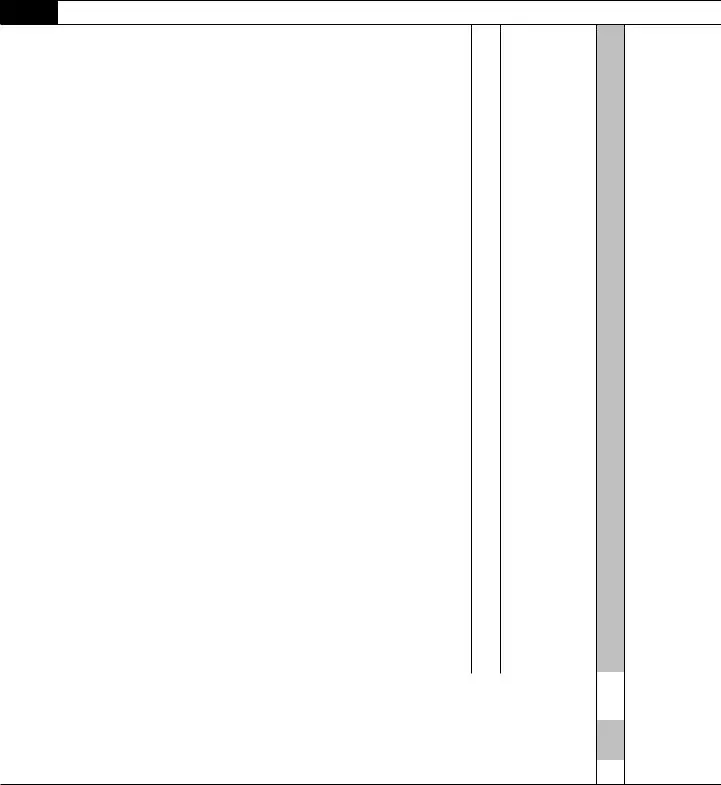SCHEDULE 2
(Form 1040)
Department of the Treasury Internal Revenue Service
Additional Taxes
▶Attach to Form 1040, 1040-SR, or 1040-NR.
▶Go to www.irs.gov/Form1040 for instructions and the latest information.
OMB No. 1545-0074
2021
Attachment Sequence No. 02
Name(s) shown on Form 1040, 1040-SR, or 1040-NR |
Your social security number |
|
|
Part I |
Tax |
|
|
|
|
|
|
1 |
Alternative minimum tax. Attach Form 6251 |
1 |
|
2 |
Excess advance premium tax credit repayment. Attach Form 8962 |
2 |
|
3 |
Add lines 1 and 2. Enter here and on Form 1040, 1040-SR, or 1040-NR, line 17 . . |
3 |
|
Part II |
Other Taxes |
|
|
|
|
|
|
|
4 |
Self-employment tax. Attach Schedule SE |
4 |
|
5Social security and Medicare tax on unreported tip income.
6Uncollected social security and Medicare tax on wages. Attach
|
Form 8919 |
6 |
|
|
7 |
Total additional social security and Medicare tax. Add lines 5 and 6 |
|
7 |
8 |
Additional tax on IRAs or other tax-favored accounts. Attach Form 5329 if required |
|
8 |
9 |
Household employment taxes. Attach Schedule H |
9 |
10Repayment of first-time homebuyer credit. Attach Form 5405 if required . . . . . 10
11 |
Additional Medicare Tax. Attach Form 8959 |
11 |
12 |
Net investment income tax. Attach Form 8960 |
12 |
13Uncollected social security and Medicare or RRTA tax on tips or group-term life
insurance from Form W-2, box 12 . . . . . . . . . . . . . . . . . . . . 13
14Interest on tax due on installment income from the sale of certain residential lots
and timeshares . . . . . . . . . . . . . . . . . . . . . . . . . . . . 14
15Interest on the deferred tax on gain from certain installment sales with a sales price
over $150,000 . . . . . . . . . . . . . . . . . . . . . . . . . . . . 15
16Recapture of low-income housing credit. Attach Form 8611 . . . . . . . . . . 16
|
|
(continued on page 2) |
For Paperwork Reduction Act Notice, see your tax return instructions. |
Cat. No. 71478U |
Schedule 2 (Form 1040) 2021 |

Schedule 2 (Form 1040) 2021 |
Page 2 |
Part II Other Taxes (continued)
17Other additional taxes:
a |
Recapture of other credits. List type, form number, and |
|
|
|
|
|
amount ▶ |
|
|
17a |
|
b |
Recapture of federal mortgage subsidy. If you sold your home in |
|
|
|
|
|
2021, see instructions |
17b |
|
c |
Additional tax on HSA distributions. Attach Form 8889 . . . . |
17c |
|
d |
Additional tax on an HSA because you didn’t remain an eligible |
|
|
|
|
|
individual. Attach Form 8889 |
17d |
|
e |
Additional tax on Archer MSA distributions. Attach Form 8853 . |
17e |
|
f |
Additional tax on Medicare Advantage MSA distributions. Attach |
|
|
|
|
|
Form 8853 |
17f |
|
g |
Recapture of a charitable contribution deduction related to a |
|
|
|
|
|
fractional interest in tangible personal property |
17g |
|
h |
Income you received from a nonqualified deferred compensation |
|
|
|
|
|
plan that fails to meet the requirements of section 409A . . . |
17h |
|
i |
Compensation you received from a nonqualified deferred |
|
|
|
|
|
compensation plan described in section 457A |
17i |
|
j |
Section 72(m)(5) excess benefits tax |
17j |
|
k |
Golden parachute payments |
17k |
|
l |
Tax on accumulation distribution of trusts |
17l |
|
m Excise tax on insider stock compensation from an expatriated |
|
|
|
|
|
corporation |
17m |
|
n |
Look-back interest under section 167(g) or 460(b) from Form |
|
|
|
|
|
8697 or 8866 |
17n |
|
o |
Tax on non-effectively connected income for any part of the |
|
|
|
|
|
year you were a nonresident alien from Form 1040-NR . . . . |
17o |
|
p |
Any interest from Form 8621, line 16f, relating to distributions |
|
|
|
|
|
from, and dispositions of, stock of a section 1291 fund . . . . |
17p |
|
q |
Any interest from Form 8621, line 24 |
17q |
|
z |
Any other taxes. List type and amount ▶ |
17z |
|
18 |
|
|
|
|
18 |
Total additional taxes. Add lines 17a through 17z |
. . . . . . . |
|
19 |
Additional tax from Schedule 8812 |
. . . . . . . |
|
19 |
20 |
Section 965 net tax liability installment from Form 965-A . . . |
20 |
|
|
|
21Add lines 4, 7 through 16, 18, and 19. These are your total other taxes. Enter here and on Form 1040 or 1040-SR, line 23, or Form 1040-NR, line 23b . . . . . . . 21
Schedule 2 (Form 1040) 2021


